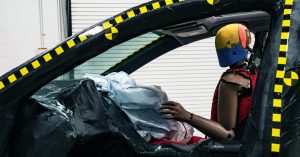“Everybody who grew up at a certain time has a story of being really scared by something they saw in The Dark Crystal,” says Javier Grillo-Marxuach, a stalwart writer of genre television and executive coproducer on a new Netflix series premiering this week, based on that 1982 movie. He ain’t lying. Dark Crystal was an epic fantasy told with sophisticated puppets, directed by the muppet creators Jim Henson and Frank Oz. If you ask a Gen Xer to name the first movie that freaked them out, Dark Crystal’s a likely answer. Boomer parents saw Henson’s name on it and figured, hey, muppets, cool.
Not cool, it turned out. Nobody expects the Skeksis Inquisition. Here was a family movie that included giant terror-mollusks, cute hobbit-like critters getting the mystical life force sucked out of them by giant squawking crow monsters, and a road adventure through the foothills of the uncanny valley. It was a singular creative achievement that today lurks menacingly under an entire generation’s collective psychological bed.
Lucky Generation Z, then, right? Because Gen X is nothing if not willing to inflict its traumas on its children, and Netflix is here to help. Yes, The Dark Crystal: Age of Resistance will, like its progenitor, freak you and your kids right the hell out in all the best ways. “We had a mantra in the writers’ room: It sure ain’t The Happy Crystal,” Grillo-Marxuach says. He and his writers described their medium as made of equal parts foam and darkness.
“We look to the spirit of the original and what Jim Henson and Frank Oz were doing,” Grillo-Marxuach adds, “and we are trying to match that spirit.”
Showrunners Will Matthews and Jeffrey Addiss originally met with Lisa Henson, Jim’s daughter and the head of the production company (her father died in 1990), to pitch a sequel to Labyrinth—another classic Henson Gen X freakout property. She said no thanks. Then Matthews and Addiss worked up a pitch for a movie sequel to Dark Crystal … and Henson told them she wanted a TV series prequel instead. It was their story arc for that show that ended up in front of Netflix.
What no one expected was that Netflix (which declined to make a representative available to speak for this story) would yes-and the team into a two-year-long workaholic fever dream. At that point, the Henson folks had been thinking about animating the show—making a cartoon. According to Addiss, Netflix told Lisa Henson the network wanted live-action. Puppets, just like the original. Lisa Henson told the streamer to start adding zeroes to the budget. Puppets are slow and expensive. Netflix, putting its reported $12-billion and climbing annual spend on content to work, said yes anyway. It might’ve helped a little that, like traditional animation, puppets are easy to dub into other languages—30 of them, in 190 countries. “It’s so rare that you have an opportunity to watch something with no humans,” Addiss says. “If you’re a German child watching, let’s say, you’re going to feel it’s made for you.”
The original movie took place after a sort of apocalypse in the world of Thra, the darkening of the eponymous crystal that’s the soul of the Thra. The new series happens, Matthews says, before that end of the world, at the peak of Thra civilization. Both the diminutive, adventurous gelflings and the corrupt overclass Skesis (the crow monsters) get multiple storylines and characters. “Dark Crystal is a world show,” Addiss adds. “You want to be in that world. But we move plot fast. We burn through it.”
For sure, Age of Resistance has a dynastic feeling. Designer Brian Froud and his wife Wendy were both back in the Creature Shop creating the basic look of Thra. They were joined by their son Toby (who also played the baby Toby in Labyrinth). Some of the puppet performers worked on the original too.
The technology of what they’re doing, though, has evolved. They’re still working from below, tucked underneath roughly 90 elaborate sets built four feet off the ground to give them room. But the controls have gotten better and more digital. One performer can now do what it sometimes took four to do in the 1980s, operating animatronics not with mechanical linkages but with a Wii controller.
The performers still often work by watching their own performances on a small monitor displaying the camera’s feed, but that’s gotten more complicated. Series director Louis Leterrier wasn’t interested in the way Henson and Oz locked off their frame before a take; he roved the set with his own Steadicam, threading among the puppets along with another camera—and sometimes one or two more to capture wider or overhead views. So the performers learned to watch not one monitor but up to four, confident that Leterrier would cut around any errant puppeteer arms or edges of the set.
The production team wasn’t sure what kind of performances they’d be able to get from the puppets, even with Henson pros inside. “We wanted to do a Skeksis walk-and-talk, Sorkin style,” Addiss says. That was a no-go. So was a scene of another Skeksis making a potion. Close-up dexterity isn’t really a puppet thing.
That’s just blocking, but it implies a bigger question. Can puppets … act? A movie star, goes one cliché, can deliver a long monologue’s worth of concept with a mere glance, or say one thing but clearly mean another. Addiss and Matthews, candidly, worried about whether a puppet could do the same. Anyway, spoiler, they could. The performers could turn body language into stories, and in fact preferred to deliver emotion with movement instead of soliloquies—those puppets are heavy.
The performances can still be a little uncanny, but the show is no less gripping for the absence of humans. In some ways, it’s actually purer. “Whether you’re writing for puppets or the cast of Game of Thrones, what helps actors with their performance is that the character is clear through the actions they take or don’t take,” Grillo-Marxuach says. “You need to be very rigorous … because the performance is mediated by so many layers.”
Alongside all the practical magic that makes those sets—caves, throne rooms, Augra’s orrery, forests, labs, banquet halls, etc.—so remarkable, digital effects build out their remotest reaches. This world feels infinitely bigger than the movie version. It also feels more intimate, since digital work can make the puppets blink, or twitch.
So it’s a bigger story, or set of stories, than the 1982 movie. The episodes I’ve watched have a grandeur that even the movie didn’t, a vastness and a sense of awe owing to the wider locations and serialized pace. They’re also, I think, even scarier. There’s a thing with an eye that’s gonna stick with me every bit as hard as the podling life-sucking.
Age of Resistance feels, in other words, like a Henson show—a vibe that will never not crack my heart a little. “When people would ask Jim Henson about Fraggle Rock, he would say, with a straight face and without fear or guilt, that he wanted the show to bring about world peace,” Grillo-Marxuach says. “I think a little bit of that spirit gets into everybody who is involved in this project. Whether it’s dark, whether it’s light, whether it’s funny, whether it’s terrifying, we are making this because we feel there’s a core principle attached to it that will help people be better.”



